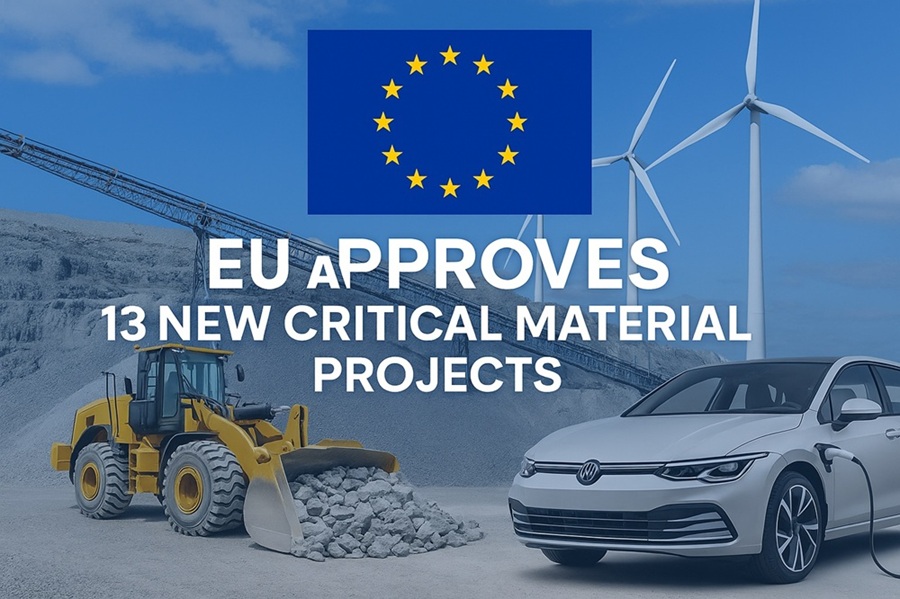In a significant move aimed at strengthening Europe’s industrial resilience and energy transition, the European Commission has officially approved 13 new strategic projects under its Critical Raw Materials Act. These initiatives, spread across several member states and partners, including a major undertaking in Greenland, are designed to secure the supply of vital resources such as lithium, cobalt, rare earth elements, and nickel—all essential to electric vehicle (EV) batteries, wind turbines, and other green technologies.
A Bold Step Toward Resource Independence
The announcement comes amid growing global competition over access to critical raw materials, with China, in particular, dominating global supply chains. Europe currently relies on imports for more than 80% of its critical raw material needs, a dependence seen as unsustainable given current geopolitical tensions and rising global demand for green technologies.
Thierry Breton, the EU’s Internal Market Commissioner, emphasized the strategic importance of the decision. “Europe cannot afford to be vulnerable in this new industrial era. These projects are not just about mining—they’re about sovereignty, security, and sustainability.”
What Are the 13 Projects?
The newly approved projects span exploration, extraction, processing, and recycling of critical materials. While the full list has yet to be released publicly, highlights include:
A large-scale lithium mining and processing facility in Greenland, backed by both Danish and EU financing.
Cobalt extraction in Finland, building on existing mining infrastructure.
Nickel processing in Portugal, where EV battery producers have already begun localizing production.
Rare earth element recovery from electronic waste in Germany and Belgium, using advanced recycling technologies.
Graphite refinement in Sweden, aimed at powering Europe’s growing battery gigafactory ecosystem.
Each project has been designated as a Strategic Project, meaning it will benefit from faster permitting processes, streamlined environmental assessments, and priority access to public funding, including from the EU Innovation Fund and InvestEU.
Greenland: The Rising Star of EU Resource Policy
Perhaps the most geopolitically notable aspect of the announcement is the inclusion of Greenland. Long viewed as a largely untapped resource frontier, Greenland’s inclusion signals the EU’s ambition to diversify beyond traditional suppliers and secure access to raw materials under stable, friendly jurisdictions.
The lithium initiative in Greenland is expected to produce enough lithium to support the manufacture of up to 2 million EV batteries annually by the early 2030s. While environmental concerns have surfaced, local authorities have expressed support, citing the project's potential for economic growth and employment.
Greenland’s Minister for Mineral Resources, Ane Lone Bagger, stated: “We are pleased to partner with the EU on responsible resource development. This project will bring innovation and infrastructure to our communities while contributing to Europe’s green transformation.”
Strategic Autonomy and Industrial Competitiveness
The new projects are part of the EU’s broader Critical Raw Materials Act, adopted in 2024. The legislation sets ambitious targets: by 2030, at least 10% of the EU’s annual consumption of strategic raw materials must be extracted domestically, 40% processed within the bloc, and 15% recycled. The act also mandates the identification of at least one Strategic Project per member state to ensure equitable access and regional development.
For Europe’s green and digital transition plans—especially the Fit for 55 climate package and the REPowerEU energy independence strategy—these materials are indispensable. The demand for lithium alone is expected to increase twelvefold by 2035, according to the European Battery Alliance.
European Commission President Ursula von der Leyen praised the approval as “a turning point for Europe's economic and ecological future,” asserting that “supply security is the bedrock of clean technology leadership.”
Environmental Safeguards and Public Transparency
Despite the fast-tracking mechanisms, the Commission has underscored that environmental due diligence will not be compromised. All Strategic Projects must adhere to EU environmental and social standards, conduct public consultations, and present comprehensive impact assessments.
Environmental groups have called for vigilance. Greenpeace EU spokesperson Laura Tenenbaum noted: “While we recognize the need for critical minerals, the EU must avoid replacing fossil dependence with mining dependence. Strict environmental controls and full transparency are essential.”
The Commission has responded by announcing the launch of a Critical Materials Observatory, which will monitor the implementation, environmental impact, and market conditions surrounding these projects.
What’s Next?
Member states are expected to finalize national implementation plans by the end of Q3 2025, with several projects projected to break ground as early as mid-2026. The European Investment Bank (EIB) has already pledged €2.5 billion in potential financing for eligible ventures, while public-private partnerships are being explored for longer-term supply agreements.
Industry players—from automotive giants like Volkswagen and Stellantis to battery startups in the Nordic region—have welcomed the news, seeing it as a major step toward supply chain stability and cost control.
Conclusion
As the global race for critical materials heats up, the European Union is asserting its ambition not just to compete, but to lead. By backing 13 diverse, strategically located projects, the EU is laying the foundation for economic resilience, technological leadership, and environmental stewardship in the decades ahead.
For a continent striving for green autonomy and geopolitical balance, these critical materials may very well be Europe’s new gold.
